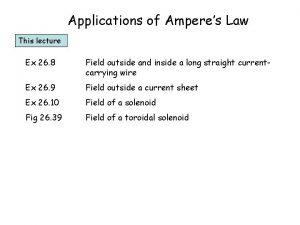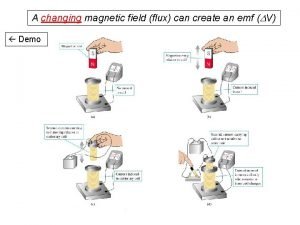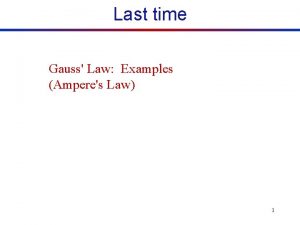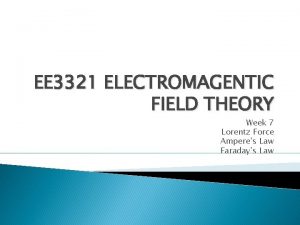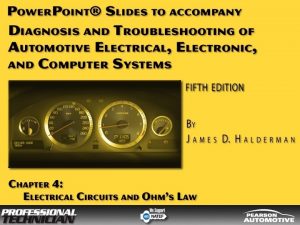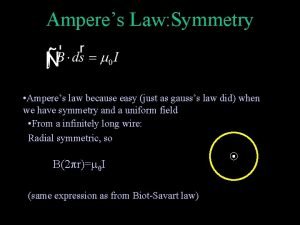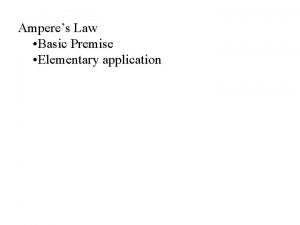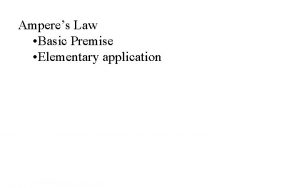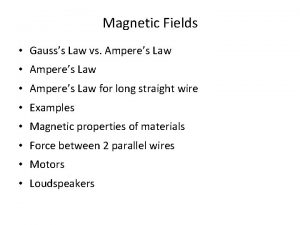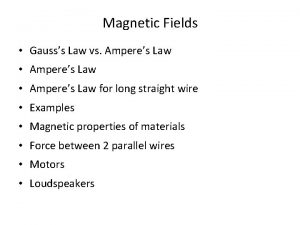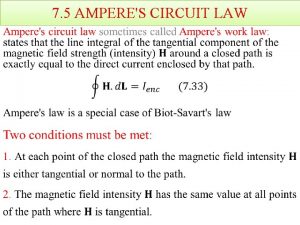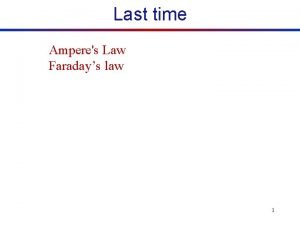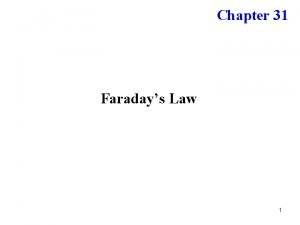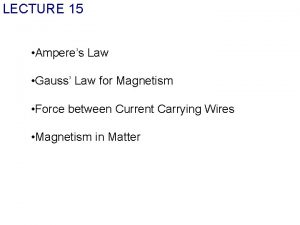4 Amperes Law and Applications As far as














- Slides: 14

4). Ampere’s Law and Applications • As far as possible, by analogy with Electrostatics • B is “magnetic flux density” or “magnetic induction” • Units: weber per square metre (Wb m-2) or tesla (T) • Magnetostatics in vacuum, then magnetic media based on “magnetic dipole moment”

Biot-Savart Law • • The analogue of Coulomb’s Law is the Biot-Savart Law d. B(r) r r-r’ Consider a current loop (I) O • I For element dℓ there is an associated element field d. B perpendicular to both dℓ’ and r-r’ same 1/(4 pr 2) dependence o is “permeability of free space” defined as 4 p x 10 -7 Wb A-1 m-1 Integrate to get B-S Law r’ dℓ’

B-S Law examples (1) Infinitely long straight conductor dℓ and r, r’ in the page d. B is out of the page B forms circles centred on the conductor Apply B-S Law to get: I dℓ q r’ z O r - r’ r a d. B q = p/2 + a sin q = cos a = B

B-S Law examples (2) “on-axis” field of circular loop dℓ Loop perpendicular to page, radius a dℓ out of page and r, r’ in the page On-axis element d. B is in the page, perpendicular to r - r’, at q to axis. r - r’ I r’ a r z Magnitude of element d. B Integrating around loop, only z-components of d. B survive The on-axis field is “axial” d. B q d. Bz

On-axis field of circular loop dℓ r - r’ I r’ a Introduce axial distance z, where |r-r’|2 = a 2 + z 2 2 limiting cases: r z d. B q d. Bz

Magnetic dipole moment The off-axis field of circular loop is much more complex. For z >> a it is identical to that of the electric dipole m m “current times area” vs p “charge times distance” q r

B field of large current loop • • Electrostatics – began with sheet of electric monopoles Magnetostatics – begin sheet of magnetic dipoles Sheet of magnetic dipoles equivalent to current loop Magnetic moment for one dipole m = I a area a for loop M = I A area A • Magnetic dipoles one current loop • Evaluate B field along axis passing through loop

B field of large current loop • Consider line integral B. dℓ from loop • Contour C is closed by large semi-circle which contributes zero to line integral I (enclosed by C) z→-∞ a C z→+∞ mo I mo. I/2

Electrostatic potential of dipole sheet • • Now consider line integral E. dℓ from sheet of electric dipoles m = I a I = m/a (density of magnetic moments) Replace I by Np (dipole moment density) and mo by 1/eo Contour C is again closed by large semi-circle which contributes zero to line integral Np/2 eo Electric magnetic -Np/2 eo Field reverses no reversal

Differential form of Ampere’s Law Obtain enclosed current as integral of current density B Apply Stokes’ theorem j dℓ Integration surface is arbitrary S Must be true point wise

Ampere’s Law examples (1) Infinitely long, thin conductor (2) (3) B is azimuthal, constant on circle of radius r (4) Exercise: find radial profile of B inside and outside conductor of radius R B R r B

Solenoid Distributed-coiled conductor Key parameter: n loops/metre B I If finite length, sum individual loops via B-S Law If infinite length, apply Ampere’s Law B constant and axial inside, zero outside Rectangular path, axial length L I L (use label Bvac to distinguish from core-filled solenoids) solenoid is to magnetostatics what capacitor is to electrostatics

Relative permeability Recall how field in vacuum capacitor is reduced when dielectric medium is inserted; always reduction, whether medium is polar or non-polar: is the analogous expression when magnetic medium is inserted in the vacuum solenoid. Complication: the B field can be reduced or increased, depending on the type of magnetic medium

Magnetic vector potential For an electrostatic field We cannot therefore represent B by e. g. the gradient of a scalar since Magnetostatic field, try B is unchanged by
 Applications of ampere's law
Applications of ampere's law Ampere maxwell law
Ampere maxwell law Gauss law and ampere's law
Gauss law and ampere's law Amperes law
Amperes law Differential form of amperes law
Differential form of amperes law Paper seeming boy figure of speech
Paper seeming boy figure of speech Rhyming scheme of an elementary school classroom in a slum
Rhyming scheme of an elementary school classroom in a slum In a kingdom far far away
In a kingdom far far away Far far away city
Far far away city If two insulated wires were to melt together
If two insulated wires were to melt together Newton's first law and second law and third law
Newton's first law and second law and third law Newton's first law of motion
Newton's first law of motion Boyles law
Boyles law Constant in avogadro's law
Constant in avogadro's law Hittorf
Hittorf
